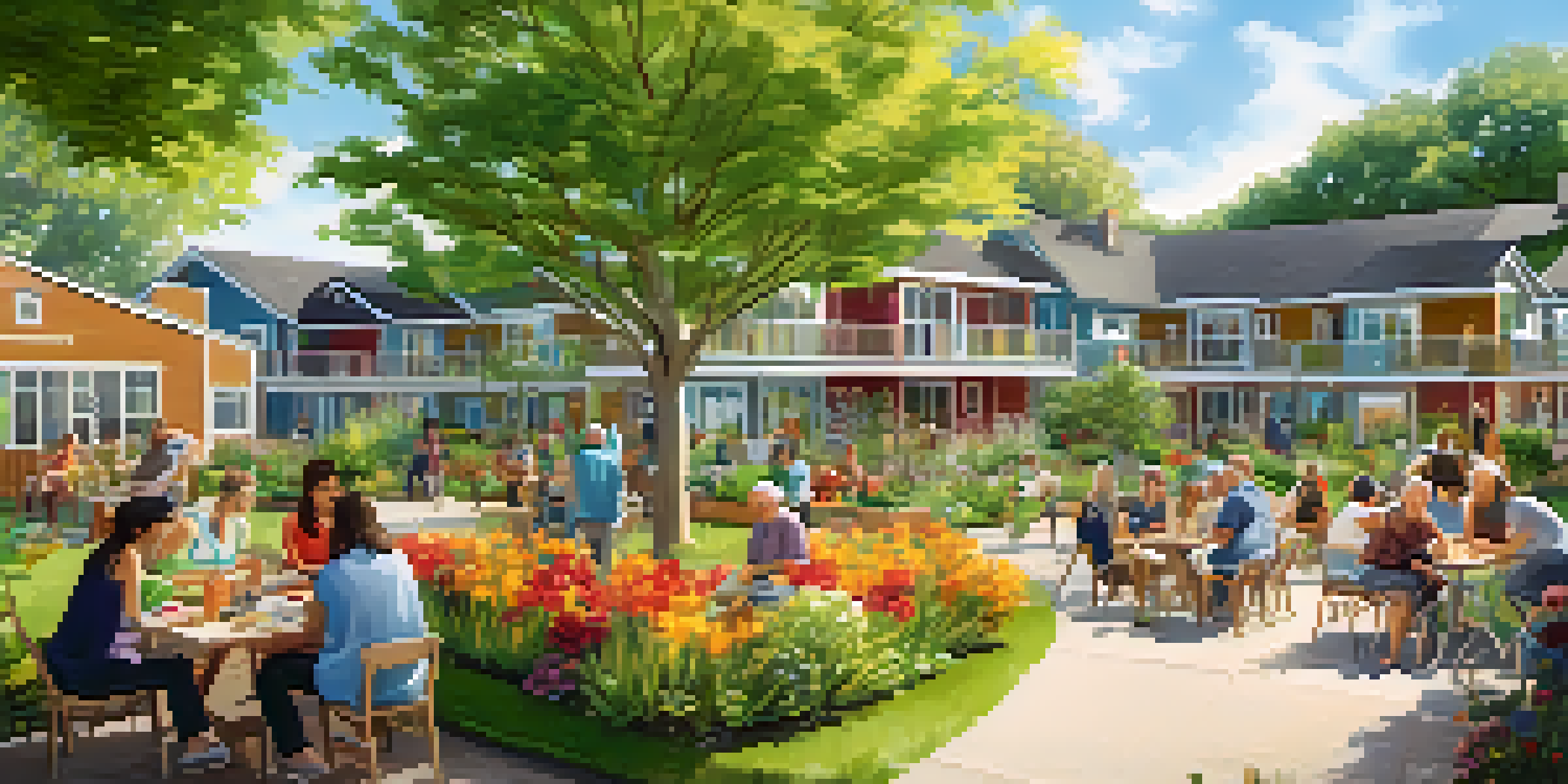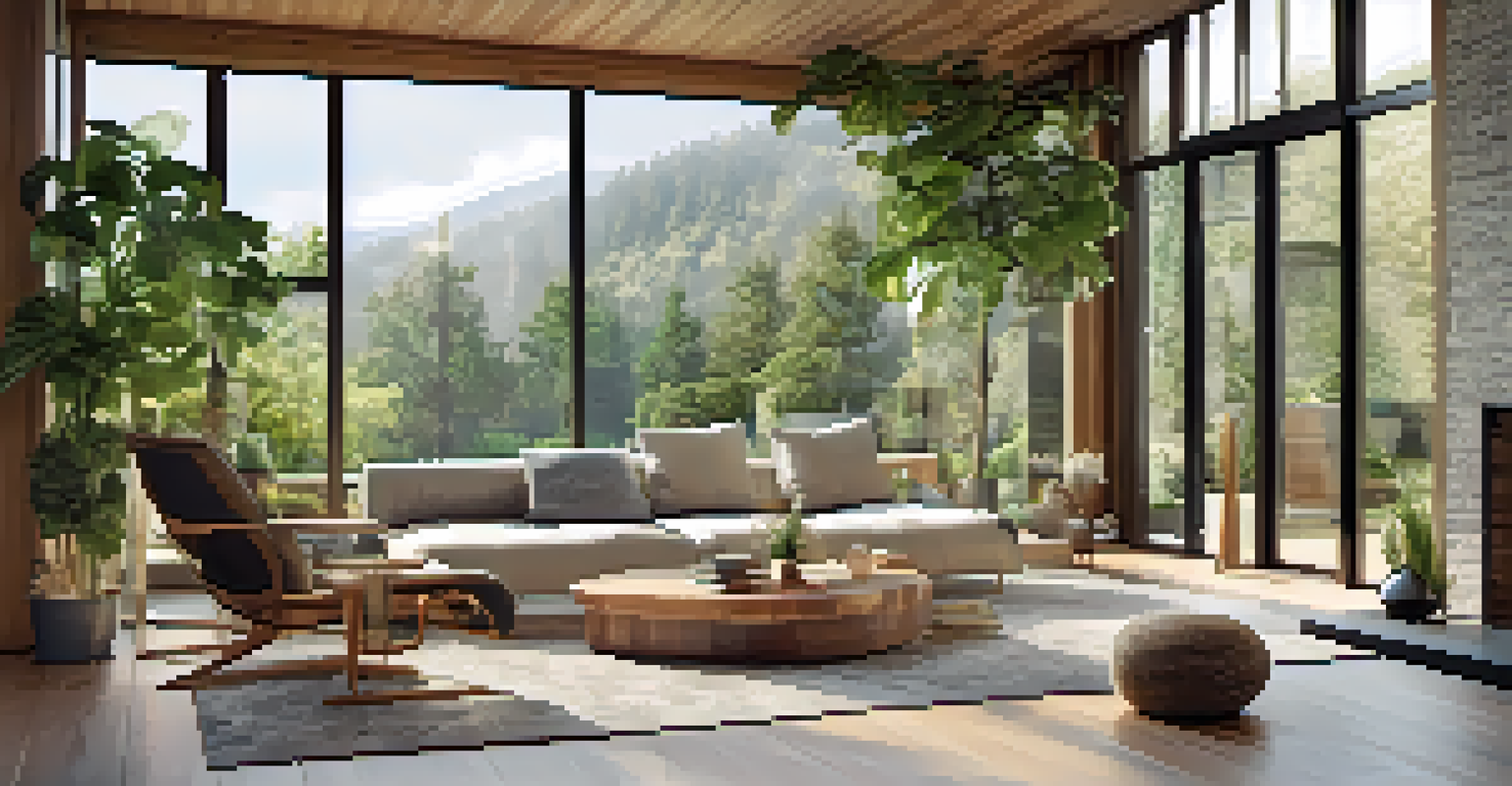The Role of Community in Future Home Design Trends

The Importance of Community in Home Design
Community plays a pivotal role in shaping how homes are designed and built. As people increasingly seek to create spaces that foster connection, the design process must consider social dynamics and shared values. Homes are no longer just individual sanctuaries; they are integral parts of vibrant neighborhoods.
The greatness of a community is most accurately measured by the compassionate actions of its members.
When architects and designers focus on community needs, they create spaces that encourage interaction and build relationships. For instance, community gardens and shared recreational spaces can enhance the living experience while promoting sustainability. By prioritizing communal areas, home designs can reflect the collective spirit of the neighborhood.
Ultimately, a strong sense of community can lead to happier residents and more resilient neighborhoods. As we move forward, home designs that embrace and celebrate this connection will likely become more prevalent, reflecting the desires of modern homeowners.
Sustainability and Community Engagement
Sustainability is a key concern for many communities today, influencing home design trends significantly. By involving community members in the planning process, designers can create sustainable solutions that everyone supports and benefits from. For example, residents can collaborate on initiatives like solar panel installations or rainwater harvesting systems.

These community-driven sustainability projects not only reduce the environmental impact but also foster a sense of ownership among residents. When people feel invested in their environment, they are more likely to maintain and protect it. This leads to more resilient communities that can adapt to changing conditions.
Community Shapes Home Design
Modern home design emphasizes the importance of community by creating spaces that foster connection and reflect shared values.
Moreover, sustainable home designs that prioritize local resources and eco-friendly materials can contribute to a healthier living space. As communities embrace these practices, home design will increasingly reflect the collective commitment to creating a sustainable future.
Technology and Community Connectivity
As technology continues to evolve, its integration into home design will enhance community connectivity. Smart home devices and online platforms can facilitate better communication among residents, fostering a sense of unity. For instance, neighborhood apps can help residents share resources or organize local events.
We do not inherit the earth from our ancestors; we borrow it from our children.
Furthermore, technology can create homes that adapt to the needs of the community. For example, multi-purpose spaces equipped with advanced technology can host events, workshops, or even remote work settings. This flexibility ensures that homes serve a variety of functions, promoting inclusivity and engagement.
In essence, as we design homes that incorporate technology, we have the opportunity to strengthen community ties. Future home designs will likely prioritize these digital connections, allowing neighborhoods to thrive in an increasingly interconnected world.
Designing for Inclusivity and Diversity
Inclusivity and diversity are essential elements in modern home design, reflecting the varied needs of community members. Designers are now tasked with creating spaces that cater to different lifestyles, family structures, and cultural backgrounds. This approach ensures that everyone feels welcome and represented in their living environment.
For example, multi-generational homes that accommodate various age groups can foster stronger family ties and support systems. Likewise, designs that consider accessibility for individuals with disabilities can enhance community engagement and participation. By embracing diversity, home design becomes a true reflection of the community it serves.
Sustainability Through Collaboration
Engaging community members in sustainability initiatives leads to innovative home designs that benefit both the environment and residents.
As communities continue to evolve, the demand for inclusive designs will grow. This trend not only enriches the living experience but also cultivates a sense of belonging among residents, reinforcing the idea that home is where everyone has a place.
The Rise of Co-Housing Communities
Co-housing communities are gaining popularity as an alternative to traditional living arrangements, fostering a strong sense of community. These intentional neighborhoods prioritize shared spaces and resources, allowing residents to connect more deeply. This model encourages collaboration and social interaction among neighbors, creating a supportive environment.
In co-housing, individual homes are designed around communal facilities like kitchens, gardens, and gathering areas. This arrangement not only reduces living costs but also promotes a lifestyle centered on cooperation and shared experiences. Residents often participate in decision-making, ensuring that the community reflects their collective values.
As more people seek connection and support, the co-housing trend is likely to grow. This shift in home design reflects a broader desire for community-oriented living, where collaboration and connection are at the forefront.
Nature-Inspired Design: Bringing the Outdoors In
Nature-inspired design is becoming a focal point in home architecture, emphasizing the importance of green spaces in community living. By incorporating elements like gardens, parks, and green roofs, homes can promote a sense of tranquility and well-being. This connection to nature fosters a healthier lifestyle for residents, enhancing their overall quality of life.
Communities that prioritize green design often see benefits beyond aesthetics. Nature-rich environments can improve mental health, reduce stress, and encourage outdoor activity. For instance, homes designed with large windows and open spaces can invite natural light and views of the surrounding landscape, creating a seamless indoor-outdoor experience.
Technology Enhances Connectivity
Integrating technology in home design improves community connectivity, allowing for better communication and resource-sharing among residents.
As we look to the future, integrating nature into home design will be crucial for creating vibrant, health-focused communities. This trend not only beautifies neighborhoods but also reinforces the connection between residents and their environment.
The Future of Community-Centered Home Design
Looking ahead, the future of home design will heavily emphasize community-centered approaches. As societal values shift towards connection and collaboration, architects and designers will respond by creating spaces that reflect these priorities. This evolution will likely lead to innovative designs that accommodate diverse lifestyles and promote social interaction.
Moreover, the integration of technology, sustainability, and inclusivity will shape how communities develop. Designers will need to be attuned to the needs and desires of residents, ensuring that homes are not just structures but vital components of a thriving community. The emphasis will be on creating environments that foster relationships and enhance the overall quality of life.

In conclusion, the role of community in home design is set to become increasingly significant. As we envision the future, it's clear that homes will be designed not only for individuals but for the collective well-being of the communities they inhabit.